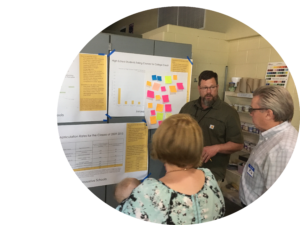 Summer isn’t quite here, but it’s on the horizon for many students and educators. As we wrap up the 18-19 school year, A+ delivers to you: a deeper look into Cañon City’s innovative schools, data suppression concerns, a preview of the new policies from the legislative session and what they may mean for Colorado kids, a decision for Adams 14, and of course… more!
Summer isn’t quite here, but it’s on the horizon for many students and educators. As we wrap up the 18-19 school year, A+ delivers to you: a deeper look into Cañon City’s innovative schools, data suppression concerns, a preview of the new policies from the legislative session and what they may mean for Colorado kids, a decision for Adams 14, and of course… more!
A+ Updates
Community EdData Hub: Understanding Cañon City’s Innovative Schools
The Community EdData Hub (CEDH) partnered with Civic Canopy to help provide Cañon City information on their innovative schools, including their strengths and opportunities for growth, as they undertake a community-wide strategic planning process to attract and retain talented teachers. The CEDH was happy to provide information to help ensure that this dynamic conversation, which has brought community members from all sectors together to discuss Cañon City’s schools, was data-driven and based on a contextual understanding of their districts’ performance.
See the analysis provided by the Community EdData Hub and how you can get involved.
A+ Delivers Public Comment on Growth to Standard
 During the State Board of Education’s May meeting, Lisa Berdie, Policy and Research Director, gave public comment expressing A+’s concerns that the Colorado Department of Education is letting data suppression rules get in the way of providing actionable information around whether schools are supporting students who are behind to catch-up to grade level standards, separate from whether schools are helping students already on grade-level to continue to meet those expectations. Read the full comment here.
During the State Board of Education’s May meeting, Lisa Berdie, Policy and Research Director, gave public comment expressing A+’s concerns that the Colorado Department of Education is letting data suppression rules get in the way of providing actionable information around whether schools are supporting students who are behind to catch-up to grade level standards, separate from whether schools are helping students already on grade-level to continue to meet those expectations. Read the full comment here.
How Do We Determine What Makes a “Good” School?
Coming Soon from A+ Colorado is the release of Denver’s Next Journey: Communicating “Good Schools” to Families, the 4th brief of a multi-part series exploring how and if families can easily understand whether schools within DPS are serving students well. The brief will feature a dive into the creation of the School Performance Framework (SPF), Denver’s school management tool, during a time when calls to alter, dramatically change or eliminate the SPF have gotten louder.
This brief explores: what the SPF tell us; the common debate of the purpose and what is included in the SPF; and how the district has sought to identify both schools in need of support and high quality schools.
This is one you don’t want to miss from A+ as we reflect on school quality in the past, lessons learned, and how we move forward to better help the community understand school quality in Denver. As part of Navigating Denver’s Next Journey, we encourage you to continue sharing your thoughts. Catch up and read previous Denver’s Next Journey briefs.
Private School Vouchers, What’s The Point?
Last month A+’s President, Van Schoales had the pleasure of participating in a debate, hosted by Empower Illinois, on private school vouchers in Chicago. Van argued against the use of public funds for private school vouchers as part of a unique forum that was respectful of all points of view with a fact-based discussion, a rare thing these days, on education or any other policy.
Read about Van’s experience and listen to the debate’s highlights here.

News to Share
A Long-Awaited Decision for Adams 14
The Colorado State Board of Education made a historic decision with a 6-1 vote to award a district turnaround contract with MGT, a for-profit Florida-based consulting group, to be the education management partner with the Adams 14 school district. This decision has set a precedent for how Colorado intervenes in its most chronically challenged districts.
Colorado’s law for intervening in school districts that fail to meet the most basic academic expectations has been fraught with design and process problems. Our current law with the constraints of local control does not empower the State Board of Education, our Governor or anyone else to step in when there is overwhelming evidence that students are being denied a quality education. Adams 14 has been struggling for more than a decade with the state’s lowest achievement scores combined with a series of management problems. The process requires that the Adams 14 school board make a decision about the education management organization which makes little sense given this is the same board that has overseen the district’s performance.
Regardless of the overall challenges with the state policy framework, we hope that the decision to marry MGT with the Adams 14 district will be an opportunity to do a true turnaround. We expect the Colorado Department of Education to keep a close watch on what happens next in Adams 14. The community and their children deserve great public schools as our constitution promises to all children. We hope to see signs of positive changes soon, and we will continue to track this process and provide updates on next steps.
Session Ends… What’s Next for Colorado Kids?
The end of the 2019 legislative session heralds in a new set of policies that the state, districts, and schools now have to figure out how to implement. This is where the hard work begins. With funded full-day kindergarten, schools and districts will need to figure out new staffing needs and facilities. New READ Act implementation guidelines will necessitate reflection on how interventions are tied to foundational reading skills, and an independent evaluation will look at program and intervention efficacy. Districts can opt to participate in numerous pilot programs. For example, one pilot allows districts to develop supplemental accountability measures to capture different measures of student learning and experience. Another allows schools to rethink school counselor staffing, ensuring mental health staff follow students through school. Another helps districts automatically enroll students at grade-level in advanced coursework.
Each new policy and program will require new rules and new practices. At A+ we will be keeping an eye on how educators across the state implement these policies, as we look to learn from places that are best leveraging these policies to support students and teachers.
Teacher Appreciation Spotlight
May 6th marked the beginning of #TeacherAppreciationWeek, and A+ Colorado is grateful for the educators who work extremely hard to pave the way for our students, not only during this week, but every week.
We asked our readers to share a short story of a teacher who is currently in the classroom and making a significant impact on the lives of students. These stories are moving, and we are thankful for these teachers who are out in the field teaching and leading the next generation.
A+ Answers: Where are students of color graduating at a high rate in Colorado?
The community voted and 62% of voters wanted to know, “Where are students of color graduating at a high rate in Colorado?” Over the past several years, Colorado’s graduation rates for all groups of students has been increasing, across the state. However, when looking at where students of color are graduating at the highest rate, it’s clear that many of the schools with the highest graduation rates are concentrated in the 1-25 corridor, from Fort Collins down to Colorado Springs. This is true for white students as well save for a notable outlier: Grand Junction has some of the highest graduation rates in the state for white students.
Data Note: To calculate which schools had the highest graduation rates for students of color we focused on schools that were amongst the 10% of schools statewide with the largest classes of students for a different racial group. This is because many schools in Colorado have 2 or 3 students of color, all of whom graduate. However, we felt that the spirit of the question was really where do students of color have the best odds of graduating on-time. To answer this, we wanted to look at schools with significant populations of students of color and didn’t want rankings to be based on schools with small populations. This is one way to look at this question, but many other methods could also be used. We felt this method ensured we were focused on the schools where the vast majority of students who belong to smaller demographic groups attend.
Ask The Next A+ Answers. Get in contact with us!
Upcoming Events
July 22-26, 2019 | Education Systems Leadership and Policy Institute
A+ in the News
Education Reform as We Know It Is Over. What Have We Learned?, Education Week
Want A+ Colorado news delivered to your inbox? Subscribe!
